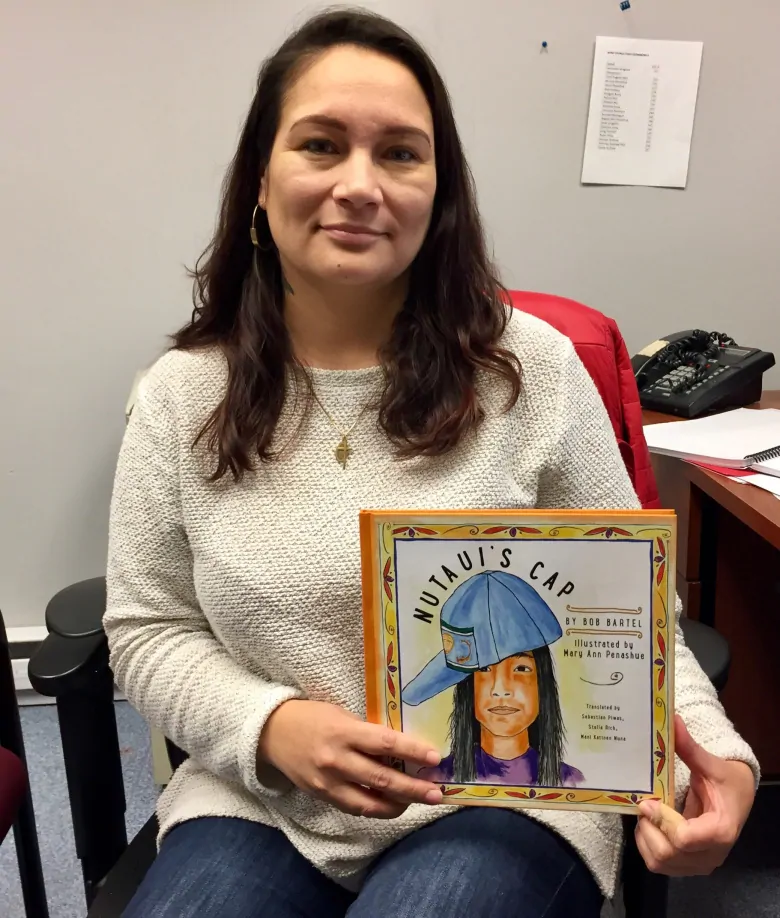New children's book is based on Innu protests of low-level flying in Labrador

A new children’s book tells the story of Innu protests against low-level flying in Labrador in the late 1980s and early 1990s is told through the eyes of a young Innu girl.
“I’m excited. All of the characters and the story, they’re all real, so it’s nice to see it come to life,” Elena Andrew of Sheshatshiu — the girl at the heart of Nutaui’s Cap — told CBC Radio’s Labrador Morning.
Nutaui means “my father” in Innu-aimun, and Andrew’s father wore an Innu Nation cap, one with two antlers in the logo, when she was growing up.
In the story, Nutaui teaches his daughter Nanass about hunting and fishing in the country, but their way of life is disrupted by supersonic jets flying over Labrador.
As a seven- or eight-year-old, Andrew remembers being frightened by those jets flying fast and low over a camp she and her family had in nutshimit (the country) near a military bombing range, she said.
“They were literally right over your head,” Andrew said.
“At one time, we had a helicopter fly over our camp and there were guys that had guns, like not necessarily pointed at us, I can’t say that, but, I mean, the doors were open like, you know, those military-style helicopters, so I mean it was scary.”
Disruption to way of life
Andrew said Innu were angered by the low-level flights, and the noise affected animals in the country.
“I remember birds falling out of the trees from the sonic boom, yeah, so it was scary. I mean, people were frustrated that this was going on on their homeland,” Andrew said. So the community decided to take action, she said.
Her father, Ben Andrew, was involved in organizing the community-led protests.

Andrew recalls people from Sheshatshiu like her grandmother, aunts and uncles occupying the military runway at Wing Goose Bay later that spring, shouting, “We don’t want NATO!”
She said they found a way to get through the razor wire set up to stop them.
“My aunt Paula got her hand pretty badly cut by the razor wire, and she’s actually in the book, but that part isn’t,” Andrew said.
Father’s cap
Andrew’s father was among those who were arrested in the protests, and when police put him into the vehicle, his Innu Nation cap fell off of his head.
Andrew said she made a run for it and grabbed it from the runway before she and others who weren’t being arrested were put onto a bus.

“My dad was obviously arrested so he didn’t come home that night, and I guess I missed him, and I ended up sleeping with the cap,” Andrew said. She added that she didn’t understand what was happening and was sad to see her father taken away.

Andrew said a volunteer with the Mennonite Central Committee in Happy Valley-Goose Bay during the protests heard the story through one of her aunts. And after asking permission, Bob Bartel wrote the book — officially launched in St. John’s on Tuesday — inspired by Andrew’s experiences.
Right to self-determination
The story is illustrated by Innu artist Mary Ann Penashue, and is translated into two dialects of Innu-aimun spoken in Sheshatshiu and Natuashish.
The book is also in English and includes an extensive glossary and background information.
Andrew said the story of the Innu protests against low-level flying isn’t one that many people are really aware of, and she hopes children will learn about the stand that the Innu took.

“I hope that especially Innu kids take that Innu people are strong, and they definitely fight for what they believe in, ” she said, noting the story is also about the right to self-determination.
Nutaui’s Cap is a co-publication of Running the Goat and Innu Education, and is published in conjunction with UNESCO’s International Year of Indigenous Languages.





